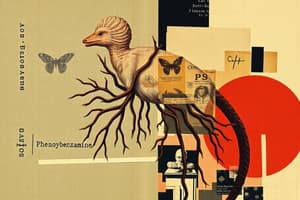Podcast
Questions and Answers
How do alpha-adrenergic antagonists reduce blood pressure?
How do alpha-adrenergic antagonists reduce blood pressure?
- By promoting sodium and water retention in the kidneys, reducing blood volume and pressure.
- By increasing peripheral vascular resistance through alpha1-mediated vasoconstriction.
- By increasing heart rate and contractility, leading to an overall decrease in blood pressure.
- By blocking postsynaptic alpha1 adrenergic receptors on vascular smooth muscles, preventing vasoconstriction. (correct)
What is a significant pharmacokinetic feature of alpha-adrenergic antagonists that prescribers should consider?
What is a significant pharmacokinetic feature of alpha-adrenergic antagonists that prescribers should consider?
- They are minimally bound to plasma proteins, resulting in low drug interaction potential.
- They have a very short half-life, requiring frequent dosing.
- They are primarily excreted unchanged in urine, necessitating dose adjustments in renal impairment.
- They undergo extensive hepatic metabolism and are highly protein bound, which may affect drug interactions and duration of action. (correct)
A 68-year-old male with hypertension and benign prostatic hyperplasia (BPH) is being considered for treatment with an alpha-adrenergic antagonist. Which of the following adverse effects is most likely to be beneficial in this patient?
A 68-year-old male with hypertension and benign prostatic hyperplasia (BPH) is being considered for treatment with an alpha-adrenergic antagonist. Which of the following adverse effects is most likely to be beneficial in this patient?
- Reflex tachycardia
- Orthostatic hypotension
- Relief of urine retention (correct)
- Decreased urinary frequency
Which of the following adverse effects is most commonly associated with the initial use of alpha-adrenergic antagonists like prazosin?
Which of the following adverse effects is most commonly associated with the initial use of alpha-adrenergic antagonists like prazosin?
A patient with hypertension and a history of depression is being considered for alpha-adrenergic antagonist therapy. What consideration is most important when prescribing this medication?
A patient with hypertension and a history of depression is being considered for alpha-adrenergic antagonist therapy. What consideration is most important when prescribing this medication?
Which mechanism primarily contributes to the regulation of vascular tone?
Which mechanism primarily contributes to the regulation of vascular tone?
How do Angiotensin II Receptor Blockers (ARBs) such as valsartan, lower blood pressure?
How do Angiotensin II Receptor Blockers (ARBs) such as valsartan, lower blood pressure?
A patient with hypertension is started on an ACE inhibitor. Which of the following adverse effects is most directly related to the mechanism of action of this drug?
A patient with hypertension is started on an ACE inhibitor. Which of the following adverse effects is most directly related to the mechanism of action of this drug?
A patient with hypertension also has type 2 diabetes and early-stage kidney disease. Which class of antihypertensive drugs would be most beneficial in providing both blood pressure control and kidney protection?
A patient with hypertension also has type 2 diabetes and early-stage kidney disease. Which class of antihypertensive drugs would be most beneficial in providing both blood pressure control and kidney protection?
Why do Angiotensin II Receptor Blockers (ARBs) cause less or no dry cough, in comparison to ACE inhibitors?
Why do Angiotensin II Receptor Blockers (ARBs) cause less or no dry cough, in comparison to ACE inhibitors?
Which of the following mechanisms directly promotes vascular smooth muscle relaxation?
Which of the following mechanisms directly promotes vascular smooth muscle relaxation?
Nebivolol is unique among beta-blockers due to its ability to:
Nebivolol is unique among beta-blockers due to its ability to:
A patient with a history of asthma is prescribed a beta-blocker for hypertension. Which beta-blocker would be the MOSTappropriate choice?
A patient with a history of asthma is prescribed a beta-blocker for hypertension. Which beta-blocker would be the MOSTappropriate choice?
A patient taking a non-selective beta-blocker reports experiencing vivid dreams and feeling unusually down. Which of the following adverse effects is MOST likely responsible for these symptoms?
A patient taking a non-selective beta-blocker reports experiencing vivid dreams and feeling unusually down. Which of the following adverse effects is MOST likely responsible for these symptoms?
Which of the following is NOT a typical clinical use of beta-blockers?
Which of the following is NOT a typical clinical use of beta-blockers?
A patient is started on metoprolol for hypertension. What is the MOST important instruction to give the patient regarding exercise?
A patient is started on metoprolol for hypertension. What is the MOST important instruction to give the patient regarding exercise?
Which part of the nephron relies on osmotic forces created in the hypertonic medullary interstitium to extract water?
Which part of the nephron relies on osmotic forces created in the hypertonic medullary interstitium to extract water?
A patient with hypertension and anxiety is prescribed a medication that lowers blood pressure and heart rate, but the patient develops AV nodal block. Which class of medication is MOST likely responsible for this adverse effect?
A patient with hypertension and anxiety is prescribed a medication that lowers blood pressure and heart rate, but the patient develops AV nodal block. Which class of medication is MOST likely responsible for this adverse effect?
Flashcards
Hydralazine
Hydralazine
Dilates blood vessels, reducing peripheral vascular resistance and lowering blood pressure. Covered in Heart Failure Lecture.
Spironolactone/Eplerenone/Finerenone
Spironolactone/Eplerenone/Finerenone
Block mineralocorticoid receptors, reducing sodium and water retention, thus lowering blood pressure. Covered in Heart Failure Lecture.
Alpha-Adrenergic Antagonists
Alpha-Adrenergic Antagonists
Block postsynaptic alpha1-adrenergic receptors on vascular smooth muscle, preventing vasoconstriction and reducing blood pressure.
Alpha1 Receptor Function
Alpha1 Receptor Function
Signup and view all the flashcards
Alpha-blocker Side Effects
Alpha-blocker Side Effects
Signup and view all the flashcards
MLCK Role
MLCK Role
Signup and view all the flashcards
Non-selective Beta-Blockers
Non-selective Beta-Blockers
Signup and view all the flashcards
Cardioselective Beta-Blockers
Cardioselective Beta-Blockers
Signup and view all the flashcards
Mixed Beta-Blockers
Mixed Beta-Blockers
Signup and view all the flashcards
Beta-Blockers Uses: Hypertension
Beta-Blockers Uses: Hypertension
Signup and view all the flashcards
Beta-Blockers Adverse Effect: Bradycardia
Beta-Blockers Adverse Effect: Bradycardia
Signup and view all the flashcards
Beta-Blockers Adverse Effect: Bronchoconstriction
Beta-Blockers Adverse Effect: Bronchoconstriction
Signup and view all the flashcards
Loop of Henle Function
Loop of Henle Function
Signup and view all the flashcards
Antihypertensive Medications
Antihypertensive Medications
Signup and view all the flashcards
Renin-Angiotensin System (RAS)
Renin-Angiotensin System (RAS)
Signup and view all the flashcards
Ang II Type 1 (AT1) Blockers
Ang II Type 1 (AT1) Blockers
Signup and view all the flashcards
Examples of AT1 Blockers
Examples of AT1 Blockers
Signup and view all the flashcards
Benefit of AT1 Blockers
Benefit of AT1 Blockers
Signup and view all the flashcards
Study Notes
- Dr Mitchell Lai of the Department of Pharmacology is the author
- The lecture is about anti-hypertensive medications
CVS Pharmacology Lecture Topics
- Lipid Lowering Drugs
- Anti-arrhythmics
- Anti-thrombotics and Antiplatelets
- Anti-Hypertensives, Anti-Anginals (Coronary)
- Heart failure Drugs
Learning Objectives
- Review mechanisms for regulation of vascular tone
- Review the renin-angiotensin system (RAS)
- Understand the classification of blood pressure lowering drugs
- Understand the MOA of blood pressure lowering drugs
Hypertension
- Systolic blood pressure is represented by the upper number in mm Hg
- Diastolic blood pressure is represented by the lower number in mm Hg
- Normal blood pressure is less than 120/80 mm Hg
- Elevated blood pressure is 120-129/less than 80 mm Hg
- High blood pressure (hypertension) stage 1 is 130-139/80-89 mm Hg
- High blood pressure (hypertension) stage 2 is 140 or higher/90 or higher mm Hg
- Hypertensive crisis requires immediate consultation with a doctor and is defined as higher than 180/higher than 120 mm Hg
- Etiology can be due to a specific cause which occurs in less than 10% of cases
- Essential hypertension occurs in 90% of cases
- Hypertension may have familial history
Consequences of Hypertension
- Congestive heart failure
- Myocardial infarction
- Renal damage
- Cerebrovascular accidents
- Hypertension is called the silent killer
Major Factors Influencing Blood Pressure
- Arterial Blood Pressure = Cardiac Output x Peripheral Resistance
- Cardiac output is influenced by heart rate and contractility
- Peripheral resistance is influenced by arteriolar tone
- Filling pressure influences blood volume and venous tone
- Preload is the stretching of cardiac muscles before contraction and is associated with ventricular filling
- Afterload is the force against which the heart has to contract to eject the blood and is associated with peripheral resistance
Drugs Used in Hypertension
- First-line medications include ACE inhibitors, Angiotensin Receptor Blockers, Beta-blockers, and Calcium Channel Blockers
- Second-line medications include Diuretics, Hydralazine, Mineralocorticoid receptor antagonists, and alpha-blockers
Anti-Hypertension Drugs
- ACE-inhibitors include: Captopril, Enalapril, Lisinopril, Perindopril, with Lisinopril as the case drug
- Angiotensin Receptor Blockers include: Candesartan, Losartan, Valsartan, Irbesartan, Telmisartan, with Losartan as the case drug
- Beta-blockers include: Atenolol, Bisoprolol, Carvedilol, Nebivolol, Propranolol, with Bisoprolol as the case drug
- Calcium Channel Blockers (Dihydropyridines) include: Amlodipine, Nifedipine (vs Verapamil), with Nifedipine the case drug
- Diuretics (Thiazides and thiazide-like) include: Metolazone, Hydrochlorothiazide, Indapamide, with Indapamide as the case drug
- Hydralazine is a Hydralazine drug
- Mineralocorticoid receptor antagonists include: Spironolactone, Eplerenone, Finerenone, with Spironolactone as the case drug
- Alpha-blockers include: Prazosin, Alfuzosin and Terazosin
Mechanisms Controlling Blood Pressure
- Arterial blood pressure is affected by sympathetic activity, renal blood flow, and glomerular filtration rate
- Activation of β1-AR of the heart will increase cardiac output
- Activation of α1-AR in smooth muscle contracts smooth muscle to ensure any bleeding in periphery (leg links) are stopped, increasing peripheral resistance
- Decrease in renal blood flow increases Renin, which increases Ang II, which increases Aldosterone increasing Na+, H₂O retention which increases blood volume
- β1-AR is predominantly expressed beta-adrenergic receptors in cardiac myocytes
Determinants of Vascular Tone
- Myosin light chain kinase active form (MLCK*)
- Myosin-LC phosphorylation (Myosin-LC#).
- Via β1 receptors in cardiac myocytes leads to increased contractility
- Via β2 receptors in smooth muscle leads to vasodilation
- Nitrates donate NO (nitric oxide) to relax cardiac muscle
- Agonists decrease Nitric Oxide
Inhibitors of Angiotensin
- ACE-I and AT1 Blockers are inhibitors of Angiotensin
- Angiotensinogen becomes Angiotensin I via Renin
- Angiotensin I becomes Angiotensin II via ACE
- Aminopeptidase N converts (Angiotensinogen -> Angiotensin I)
- Aminopepetidase A converts (Angiotensin I -> Angiotensin II)
- Angiotensinogens that end with "-ogen" is a pre-peptide
- Angiotensin II has strong basal activity
- Angiotensin I has a little basal activity
Angiotensin Converting Enzyme Inhibitors (ACE-I)
- Lisinopril, Captopril, Enalapril are examples of ACE-I drugs
- ACE enzyme Inhibitors prevent the breakdown of bradykinin
- ACE enzyme Inhibitors prevent the conversion of Angiotensin I to Angiotensin II, preventing vasoconstriction and the production of aldosterone
- Accumulation activates formation of NO, PG -> vasodialation, leading to decreased BP
Clinical Uses of ACE-I
- Hypertension
- Cardiac failure and has a protective effect on subsequent myocardial infarctions
- Following myocardial infarction
- Renal insufficiency
Adverse Effects of ACE-I
- Severe hypotension
- Acute renal failure
- Hyperkalemia
- Angioedema
- Dry cough (bradykinin and substance P induced, vasodilation, plasma extravasation -> angioedema. Bradykinin & prostaglandin idiosyncratic reactions and can cause increased sensitivity of bradykinin-dependent airway sensory nerve fibers)
- Pregnancy is a contraindication
Ang II Type 1 (AT1) Blockers
- Valsartan, losartan, candesartan, irbesartan, and telmisartan are examples of AT1 blockers
- Ang II will normally bind to the AT1 receptor, however AT1 blockers prevent this from occurring
Adverse Effects of AT1 Blockers
- Less/no dry cough
- Pregnancy is a contraindication
Beta-Adrenoceptor Antagonists
- Beta-Blockers
MOA of Beta-Blockers
- Blockage of β1 receptors in cardiac myocytes which leads to decreased contractility.
MOA of Beta-Blockers in Cardiac Myocytes
- Beta-blockers prevent Calcium Induced Calcium Release(CICR)
MOA of Beta-Blocker Associated Bronchoconstriction
- Reduced inactivated form of MLCK = less bronchodilation = more prone to bronchoconstriction
- There may be similar effects in other vascular smooth muscle cells
Beta-Blockers: Main Types
- Mixed (3rd generation), Non-Selective and Cardioselective (Betal)
- Nebivolol is beta 1 selective in low dose / fast metabolizers (majority of population)
- quickly convert it -> lower systemic dose of drug-> Bl selective
- Nebivolol is non-selective in high dose and slow metabolizers
- Nebivolol has vasodilatory effects through increase NO release
- Propranolol, Pindolol, Carvedilol are non-selective
- Contradicted in slow metabolis wi asthma
- Atenolol and Bisoprolol, Metoprolol XL (metoprolol succinate) are cardioselective
- All drugs written in blue can treat heart failure
Clinical Uses of Beta-Blockers
- Hypertension and Cardiac failure
- Cardiac failure have protestthe effect against subsequent ones
- Following myocardial infarction
- Anxiety disorders
- Partlly blocks beta-blocker will cause I in HR, resulting in patients feeling less anxious
Adverse Effects of Beta-Blockers
- Hypotension, Bradycardia and AV nodal block
- Reduced exercise capacity because the person is is not pumping caugh to satisfy metabolic requirements
- Bronchoconstriction (esp. asthmatics) ↑ notabiliz
- CNS: Vivid dreams, clinical depression (“beta-blocker blues”)
Calcium Channel Blockers
- Dihydropyridines (DHPs)
- This is covered elsewhere
Diuretics
- It specifically covers Thiazides
- The Structure & Function of the nephron is important
Structure & Function of the nephron
- Nephron structure consists of; Afferent arteriole, Glomerulus, Arcuate artery and vein, Proximal convoluted tubule, Loop of Henle, Vasa recta, Distal convoluted tubule, Collecting Duct
Diuretics: Distal Convoluted Tubule
- It's Relatively impermeable to water, and the NaCl reabsorption therefore further dilutes the tubular fluid.
- The mechanism of NaCl is electrically neutral Na+ and Cl- cotransport.
- Ca2+ is reabsorbed by the distal convoluted tubule epithelial cell via an apical Ca2+ channel and basolateral Na+/Ca2 exchanger.
- By distal tubule the liquid is hypotonic
- Water travels out of tubule bid osmosis
Thiazides
- Hydrochlorothiazide, Indapamide are commonly prescribed thiazides
- Less water travels out of tubule wird into interstition via osmosis at collecting ducts
- thiazides inhibit NaCl reabsorption by blocking the Na+/Cl- transporter.
- thiazides enhance Ca2+ reabsorption in the distal convoluted tubule.
- The action of thiazides depends in part duy on renal PGs synthesis.
- NSAIDs (eg, aspirin, indomethacin) interfere with the actions of thiazide diuretics by reducing the PGs synthesis.
- More Cast csterp on the tubule and less Nat being produced.
- Ca2+ exchanger works better which results in mre Ca2+ mved out of tubule
- Salt remains in interstitis.
Thiazides: Clinical Use
- It mainly treats Hypertension (preferred) and Congestive heart failure;
- It also treats Nephrolithiasis due to idiopathic hypercalciuria;
- Nephrogenic diabetes insipidus is also a good use
Thiazides: Adverse Effects
- Hypokalaemic metabolic alkalosis
- Hyponatraemia
- It may cause Hyperuricaemia which involves increased rates of gout
- Hyperglycaemia
- Hyperlipidaemia
- Hypercalcaemia
MOAs of thiazide diuretics and their adverse effects
- Patients may experience a hypokalemic metabolic alkalosis due to an increase in aldosterone-mediated K+ and H+ ions excretion in the intercalated cells of the collecting duct
- MOA is to decrease sodium reabsorption and therefore decreased fluid reabsorption to reduce circulating sodium
- If hyponatremia were to occur, it would happen during the first 2 to 3 weeks of therapy, after this time, the patient is in a new steady state in which further sodium and water losses do not occur.
- Thiazide diuretics cause hypokalemia, decreased K+ in the interstitium keeps the K+ channels open for an extended time, causing the hyperpolarization of the cell, reducing exocytosis of insulin granules. May be associated with diabetes.
- Thiazides directly increase urate reabsorption in the proximal tubule by using the OAT 1 anion exchanger on the basolateral membrane and the OAT 4 urate anion exchanger on the luminal membrane
Second-line Antihypertensives
- Hydralazine, Mineralocorticoid receptor antagonists and Alpha-adrenergic antagonists are second-line antihypertensives
Second-Line Antihypertensive Medications
- Hydralazine is covered in the Heart Failure Lecture
- Mineralocorticoid receptor antagonists include; Spironolactone, Eplerenone, Finerenone are covered in the Heart Failure Lecture
- The Alpha-adrenergic antagonists include Prazosin, Alfuzosin ,Terazosin
Alpha-Adrenergic Antagonists
- The drug targets Postsynaptic alpha1 adrenergic receptors on vascular smooth muscles and mediate vasoconstriction to increase BP
- It opposes alpha1-mediated vasoconstriction, keeping vessel tone lower and reducing peripheral vascular resistance to reduce BP
PK
- Reaches peak-plasma concentration in 2.5 hours, half-life around 7 hours
- Extensively bound to plasma protein
- Metabolized in liver, excreted in faeces and bile
Adverse Effects/Indications/Contraindications
- Does not affect renal blood-flow and GFR, safe to use in patients with impaired renal function
- No demonstrated teratogenicity at clinically relevant doses
- Common early AE: reflex tachycardia / palpitations and orthostatic hypotension
- Other AE: Depression, urinary frequency, flushing
- Also indicated for symptomatic relief of urine retention due to benign prostate hyperplasia
Studying That Suits You
Use AI to generate personalized quizzes and flashcards to suit your learning preferences.




